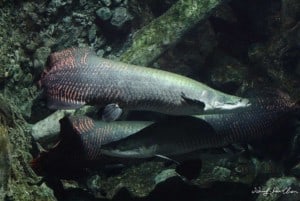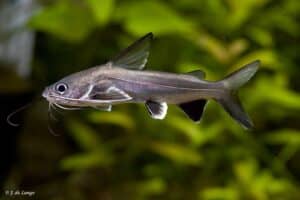Axelrodia riesei – Ruby Tetra
Axelrodia riesei was first described by Géry in 1966. The fish belongs to the family Characidae or the Characins. The genus name Axelrodia is named after Herbert R. Axelrod, a well-known aquarist and publisher. The species name riesei honors William Riese, who collected the holotype together with Axelrod. They are also called the Ruby Tetra.
Synonyms: There are no synonyms listed in the available sources.
Description
Appearance
Body Shape and Color: Axelrodia riesei, has a small, oval body that is laterally flattened. The fish is a striking red color, especially on its head and flanks, giving it its name “Ruby”. The fins are usually translucent, and there is often a black spot at the end of the caudal fin.
Size: This species reaches a maximum length of about 2-3 cm.

Differences between Males and Females
Physical Differences: Males tend to be slightly smaller and have more intense colors than females. Females tend to have a rounder body shape, particularly when they reach sexual maturity.
Behavioral differences: There are no specific behavioral differences between the sexes, but males may exhibit territorial behavior, particularly during the mating season.
Behavior and Temperament
General Behavior: Axelrodia riesei is a peaceful fish that does best in groups. They are gregarious, meaning they like to live in schools, but they do not form tight schools like some other tetras. They are active and tend to swim in the middle and upper layers of the aquarium.
Social Interaction: Although not aggressive, males may occasionally form small territories and spar with one another. They feel safer and display more interesting behavior when kept in groups of at least 8-10 individuals.
Life expectancy: In a well maintained aquarium, Ruby Tetras can live up to 3 years.
Biotope
Natural Distribution
Axelrodia riesei, also known as the Ruby Tetra, is native to the upper Meta River basin in Colombia, which is part of the larger Orinoco River system. This region is located east of Villavicencio, Colombia.
Habitat
The Ruby Tetra inhabits blackwater environments, characterized by soft, acidic water with a rich, brown color due to tannins released by decaying leaves and wood. These fish prefer smaller, wooded tributaries rather than larger river channels. The waters they thrive in are often slow-moving or nearly stagnant, featuring abundant submerged vegetation and root systems.
Environmental features
- Water Conditions: The Ruby Tetra’s natural habitat is a temperature between 20 and 28°C, a pH of 4.0 to 6.5, and very low hardness.
- Vegetation: The environment is rich in vegetation, including both aquatic and marsh plants, and contains a significant amount of organic material, such as leaves.
- Soil/Substrate: The soil consists of sand and organic material, which supports the growth of microorganisms that serve as food for the young.
Natural Enemies and Food Chain
Although specific natural predators have not been described in detail, it is likely that the Ruby Tetra feeds on small invertebrates and zooplankton. They are themselves likely prey for larger predatory fish in their natural habitat.
Climate
The Ruby Tetra inhabits a tropical climate with no distinct seasonal floods or droughts. The constant presence of organic matter and the resulting tannins create a stable, acidic water environment.

Diet
In the wild: Axelrodia riesei feeds on small invertebrates and zooplankton.
In the aquarium: They accept small-sized dry food, as well as live and frozen foods such as Artemia and Daphnia.
The Aquarium
Aquarium size
For keeping Axelrodia riesei, also known as Ruby Tetra, an aquarium with a minimum size of 60 x 30 cm is recommended. This provides sufficient space for a group of at least 8-10 fish, which is crucial for their well-being and natural behavior.
The Aquarium
- Substrate and Decoration: Use a dark sandy substrate to mimic the natural environment. Add driftwood and branches to create hiding places and give a natural look.
- Plants: The aquarium should be well planted with both rooted and floating plants. Suitable species include Microsorum, Taxiphyllum, Cryptocoryne, and floating plants such as Ceratopteris spp. These plants provide hiding places and help to dim the light, which will put the fish at ease.
- Leaf litter: Add dried leaves to the aquarium. These leaves promote the growth of microorganisms that can serve as food for the fry. The tannins released during the decomposition of the leaves are also beneficial for fish from blackwater environments.
Water parameters
- Temperature: Keep the water temperature between 20 and 28°C.
- pH: Ensure a pH between 4.0 and 6.5.
- Hardness: Water hardness should be low, ideally between 18 and 90 ppm.
Filtration
Use a filter that provides a gentle water flow, such as a sponge filter. This prevents stress for the fish and ensures stable water quality.
Suitable Tank Mates
Axelrodia riesei can coexist with other small, peaceful species such as Corydoras, Otocinclus, and small characids. Avoid larger or aggressive species that may intimidate or out-compete the Ruby Tetra at feeding time.
Breeding aquarium and conditioning
To successfully breed Axelrodia riesei, it is recommended to use a specialized breeding aquarium. This aquarium should have soft, slightly acidic water with a pH level between 4.0 and 6.5, and a temperature range of 20 to 28°C. It is crucial to have a good filtration system that provides gentle water flow, such as a sponge filter. This type of filter is ideal because it does not create a strong current, ensuring the safety of the fry.
Breeding Aquarium Setup
- Substrate and Decoration: Use a dark sandy substrate to mimic the natural environment. Add driftwood and branches to create hiding places.
- Plants: Fine-leaved plants, such as Taxiphyllum or Java moss, are ideal as the fish can lay their eggs among them. Floating plants such as Ceratopteris spp. can also be added to soften the light and create a natural environment.
- Leaf litter: Add dried leaves to the aquarium. These leaves not only provide hiding places but also promote the growth of microorganisms that can serve as food for the young fish.
- Water Quality: Ensure that the water is soft and acidic. This can be achieved by using reverse osmosis water and adding natural acids such as phosphoric acid if necessary.
- Lighting: Keep lighting dim to mimic the Ruby Tetra’s natural habitat.
Conditioning the Fish
Before you start breeding, it is important to condition the fish well. This can be done by feeding them a varied diet of live and frozen foods, such as Artemia and Daphnia. It is advisable to place a male with several females in the breeding tank and let them acclimate for a few days before removing them after the eggs have been laid.

The spawn
During the egg-laying process of Axelrodia riesei, the colors of the fish often become more vibrant. The mating ritual typically occurs in the early morning, just as the sun rises. The eggs are scattered among fine-leaved plants, such as Java moss, which creates a natural environment for spawning.
Removing the Parents
It is important to remove the parents from the breeding tank after the eggs have been laid. Axelrodia riesei tend to eat their own eggs, so removing the parents will help increase the chances of survival for the eggs. A screen over the bottom can also help protect the eggs from predation.
Number and Characteristics of Eggs
Typically, between 100 and 150 eggs are laid. These eggs are small and hard to see with the naked eye, so using a magnifying glass can be helpful for observation. The eggs hatch after about 24 to 48 hours. During this time, it is important to keep the aquarium dark, as both the eggs and the fry are sensitive to light.
Raising the fry
Hatching and Free Swimming
The eggs of Axelrodia riesei hatch after about 24 to 48 hours. The larvae first feed on their yolk sac and begin to swim freely after 3 to 4 days. It is crucial to keep the aquarium dark during this period, as the fry are sensitive to light.
Feeding the Fry
Once the fry are free swimming, they should be fed infusoria that are small enough for their mouths. After the first few weeks, you can also offer egg yolk or finely ground food. It is important to feed small amounts several times a day to maintain water quality and prevent overfeeding.
Water Quality and Maintenance
Maintaining stable water quality is essential for the survival of the fry. Water should be clean and free of contaminants, with a pH of 4.0 to 6.5 and a temperature between 20 and 28°C. Regular water changes of 20-30% per week are recommended to maintain water quality.
Survival Rate
The survival rate of fry can vary based on aquarium conditions. Providing sufficient hiding spots and a quiet environment without other inhabitants increases their chances of success.
Particularities
Axelrodia riesei is sensitive to changes in water quality and should be kept in a stable environment. They are less commonly seen in the aquarium trade due to their limited natural distribution.
Conclusion
Axelrodia riesei is a beautiful, peaceful fish suitable for experienced aquarists. They require specific water conditions and a well-planted environment. Their small size and vibrant coloration make them an attractive addition to a specialty aquarium. Although they do require some care, they are a rewarding species for those willing to meet their needs.
Video
Author
John de Lange
Copyright images
Choy Heng Wah
Michael Negrini – Pisciculture d’Estalens (originele website niet meer online)
Peter Maguire













